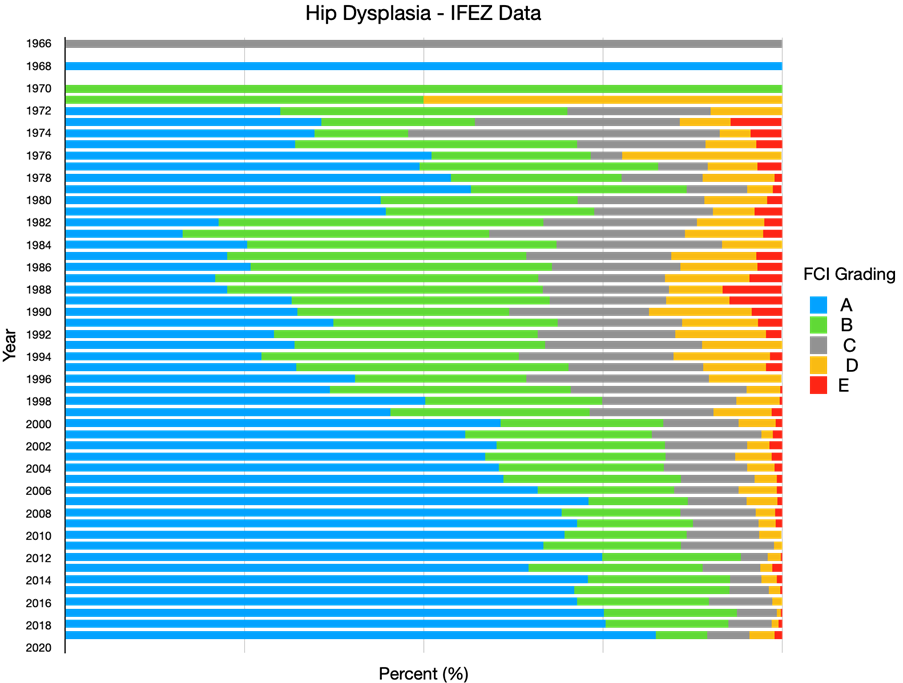Health
International Federation for Eurasier Breeding (IFEZ)
Health Recommendations
Maintaining and improving the health of our breed, according to the FCI standard No 291, is the main aim of IFEZ.
The information exchange at our meetings, as well as throughout the year, enables an exchange about strategies and new scientific recommendations in breeding. We can also discuss newly emerging diseases and many other topics. Based on this, we can formulate recommendations for the maintenance and improvement of breed health.
These comprehensive recommendations have contributed significantly to the careful breeding of our Eurasiers and their development.
The following are the essential aspects that make a membership interesting for your club
- Jointly developed health recommendations based on collected data and their evaluation for breeding
- Recording of as many health data as possible
- Information exchange at annual meetings
- Recommendation on how to observe and record diseases with a view to early recognition and suppression through selective breeding
- A working group on health, headed by an expert, wherever possible
- Lectures on health topics and breeding
- Collective blood data bank
The following are the main data collected by specialist vets and laboratories (principally Biocontrol and Laboklin) and put into the (IFEZ) database:
- Hip Dysplasia (HD)
- Patella Luxation (PL)
- Elbow Dysplasia (ED)
- Lumbosacral Transitional Vertebrae (LTV)
- Thyroid values
- Dandy-Walker-Like-Malformation (DWLM)
- Eye Screening (e.g. Glaucoma)
- Coat colours (E+S loci)
- Diabetes mellitus
- Epilepsy
Additionally, many clubs send blood samples to a blood bank (Generatio GmbH, Heidelberg, Germany) to have genetic material available in case a need arises to use material of older or deceased Eurasiers.
IFEZ Data 2024 – Hip Dysplasia
By Dr Brigitte Mordan-Grimm*, with many thanks to Georg Petermayer for the access of data from the IFEZ database.
In 2021, the IFEZ data on Hip Dysplasia were anonymised and extracted from the IFEZ database. The results are presented below.
A total of 10,284 Eurasiers have been hip scored and entered into the database. An average (arithmetic mean) of 197 dogs have been tested annually between 1966 and 2019, with a minimum of one and a maximum of 399 dogs. The average percentage of Eurasiers checked is 47.9%, with percentages much higher in later years than at the beginning of recording, broadly with percentages over 50% from1988 onwards.
The IFEZ data are presented as FCI scores, as it is these that are recorded in the IFEZ database (Table 1).
| FCI (Europe) | BVA (UK/Australia) | OVA |
| A1 | 0-4 (no more than 3/hip) | Excellent |
| A2 | 5-10 (no more than 6/hip) | Good |
| B1 | 11-18 | Fair |
| B 2 | 19-25 | Borderline |
| C | 26-35 | Mild |
| D | 36-50 | Moderate |
| E | 51-106 | Severe |
Table 1. Comparison of international hip scores: Source: https://ofa.org/diseases/hip-dysplasia/hip-international-ratings-matrix.Scores of both hips are added to get the final hip score (e.g. 3 (left) = 4 (right) =7 and would be A2 (FCI), Good (OFA)).
As is evident from Figure 2, the diligent way to test and carefully select for better hips, has resulted in a dramatic improvement of hip scores over the years within the member clubs of IFEZ since the breed’s inception about 60 years ago. This development benefits Eurasiers world-wide.
This analysis found that at least half of all Eurasiers born in the clubs associated with the Federation were scored for hip dysplasia, notably more in later years. Checking breeding animals only, still advocated by many, is the bare minimum to make breeding selections; knowledge of lateral pedigrees greatly enhances our ability to make sound breeding choices and improves predictive calculations in the IFEZ database. There are a few breeders who succeed in getting most if not all puppies they breed hip scored. We should all strive to achieve such admirable results for the benefit of future Eurasier generations! Having said that, we are certainly on the right track regarding the soundness of hips in our breed.
Figure 1. Percentage of Eurasiers hip-scored within IFEZ member clubs from 1966-2019.

Figure 2. IFEZ data for Hip Dysplasia 1966-2020. Presented as % of FCI grading (© IFEZ 2020)

*Brigitte is the Honorary Chair of the Southern Eurasier Association (SEA), which is the UK representative in IFEZ. She chairs the SEA Health Committee, is a member of the IFEZ Health Advisory Committee, and UK Breed Health Coordinator.
For any questions please contact Brigitte at alphaeurasier@gmail.com
IFEZ member associations
| EKW | - | Eurasier Klub Weinheim |
| SEK | - | Suomen Eurasier Kerho Finnland |
| EVN | - | Eurasier Vereniging Nederland |
| ECA | - | Eurasier Club Austria |
| ECB | - | Eurasierclub Belgien |
| EFS | - | Eurasier Freunde Schweiz |
| EKD | - | Eurasier Klubben Dänemark |
| USEC | - | United States Eurasier Club |
| ECI | - | Eurasier Club Italiano |
| SEA | - | Southern Eurasier Association (UK) |





